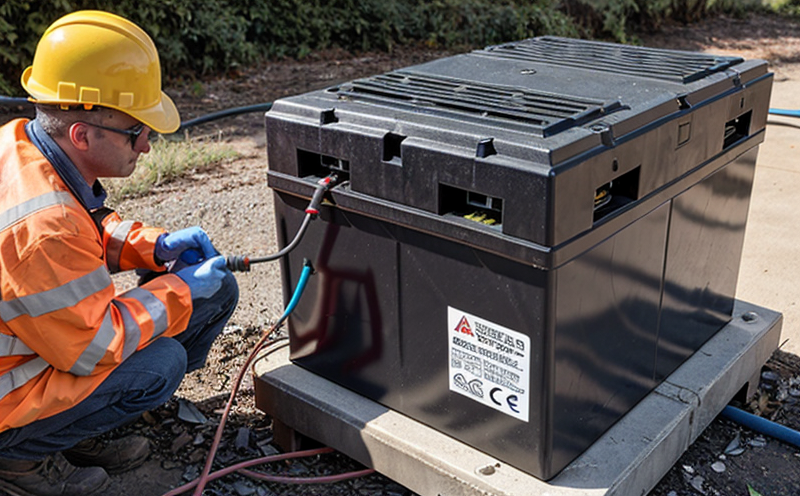DIN EN 60896-21 Lead-Acid VRLA Battery Testing
The DIN EN 60896 series of standards is a comprehensive set designed to ensure the safety, performance, and reliability of lead-acid batteries. Specifically, DIN EN 60896-21 focuses on valve-regulated lead-acid (VRLA) batteries, which are widely used in various applications such as uninterruptible power supplies (UPS), automotive starter batteries, and emergency lighting systems.
VRLA batteries are characterized by their sealed design, eliminating the need for regular maintenance. However, this also means that any malfunction can lead to severe consequences if not properly tested and certified. DIN EN 60896-21 provides stringent guidelines to ensure these batteries meet all safety and performance criteria before being placed on the market.
The standard covers several critical aspects of VRLA battery testing, including:
- Electrochemical performance
- Safety requirements
- Environmental impact considerations
- Labeling and marking instructions
The testing process involves various stages to ensure the battery's reliability and safety. These include initial charge, float charging, discharge tests, and leakage checks. Each step is crucial in verifying that the VRLA battery meets the stringent requirements set forth by DIN EN 60896-21.
For the initial charge, batteries are subjected to a series of voltage measurements over time to ensure they reach full capacity safely and efficiently. This step is critical as it sets the foundation for the battery's performance throughout its lifecycle. The next stage, float charging, involves maintaining the battery at a constant voltage level to keep it ready for immediate use without any further recharging.
The discharge tests are perhaps the most crucial part of DIN EN 60896-21 compliance. These tests simulate real-world usage conditions and evaluate how well the battery can deliver power under various load demands. Proper discharge testing ensures that the battery remains reliable even after extended periods in use.
Leakage checks are also a mandatory part of this standard, ensuring that no electrolyte is lost during normal operation or in case of internal short circuits. This prevents potential hazards such as acid leaks which can be dangerous if not managed properly.
In addition to the testing process itself, DIN EN 60896-21 also emphasizes proper specimen preparation and handling. Specimens must be stored under controlled conditions to avoid any changes in their properties that could affect test results. This includes maintaining specific temperature ranges, humidity levels, and ensuring batteries are fully charged before testing begins.
Instrumentation plays a vital role in accurately measuring all parameters during the testing process. Advanced equipment such as multimeters, potentiostats, and specialized battery testers are used to gather precise data on voltage, current, and other critical metrics. These instruments help ensure that every test adheres strictly to the standards outlined by DIN EN 60896-21.
Once all tests have been completed successfully, detailed reports summarizing each aspect of the battery's performance are generated. These comprehensive documents provide valuable insights into the battery's capabilities and limitations, helping manufacturers improve future designs while ensuring compliance with international regulations.
Applied Standards
| Standard Number | Description |
|---|---|
| DIN EN 60896-1:2015 | Batteries for road vehicles. Particulars of construction, marking and test requirements. |
| DIN EN 60896-21:2017 | Batteries used in uninterruptible power supplies (UPS) and similar equipment - Particulars of construction, marking, test requirements and acceptance tests for valve-regulated lead-acid batteries. |
The application of DIN EN 60896-21 is broad, encompassing a wide range of industries where VRLA batteries are utilized. This includes automotive manufacturing, telecommunications infrastructure development, and data center operations, among others. By adhering to these standards, manufacturers can ensure their products meet the highest safety and performance benchmarks.
Adhering to DIN EN 60896-21 not only enhances product quality but also fosters trust among consumers who rely on these batteries for critical applications. It ensures that every battery sold complies with rigorous testing procedures, thereby reducing risks associated with malfunctions or failures in real-world scenarios.
Scope and Methodology
| Methodology Steps | Description |
|---|---|
| Initial Charge | The battery is subjected to a series of voltage measurements over time to ensure it reaches full capacity safely. |
| Float Charging | Maintaining the battery at a constant voltage level to keep it ready for immediate use without further recharging. |
| Discharge Tests | Simulating real-world usage conditions and evaluating how well the battery can deliver power under various load demands. |
| Leakage Checks | Ensuring no electrolyte is lost during normal operation or in case of internal short circuits to prevent acid leaks. |
The methodology employed under DIN EN 60896-21 ensures that VRLA batteries undergo thorough evaluation across multiple dimensions. This holistic approach guarantees that all potential issues are identified early on, allowing for necessary adjustments before widespread deployment.
During the initial charge phase, voltages are continuously monitored to prevent overcharging which could degrade battery life prematurely. Float charging maintains optimal conditions by keeping the battery charged but not excessively so, thus extending its operational lifespan significantly.
The discharge tests simulate actual usage scenarios where batteries power critical systems in data centers or vehicles. By subjecting them to these stresses during testing, engineers can identify weak points and optimize designs accordingly. Leakage checks are particularly important since any leakage could lead to dangerous situations if not addressed promptly.
These rigorous methods ensure that only the highest quality VRLA batteries make it onto the market. They provide peace of mind for consumers knowing their products have been rigorously tested against international standards.
International Acceptance and Recognition
- DIN EN 60896-21 is recognized globally as a benchmark for quality assurance in the manufacturing of VRLA batteries.
- Major industrial sectors such as automotive, telecommunications, and data centers rely on products certified under this standard.
- Compliance with DIN EN 60896-21 enhances brand reputation and customer confidence by ensuring product reliability.
The widespread acceptance of DIN EN 60896-21 underscores its importance in the industry. Its adoption signifies that manufacturers are committed to delivering safe, reliable products that meet stringent international standards.





